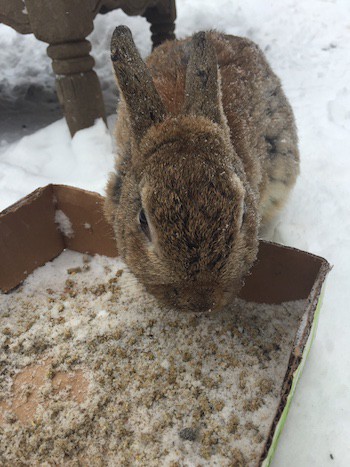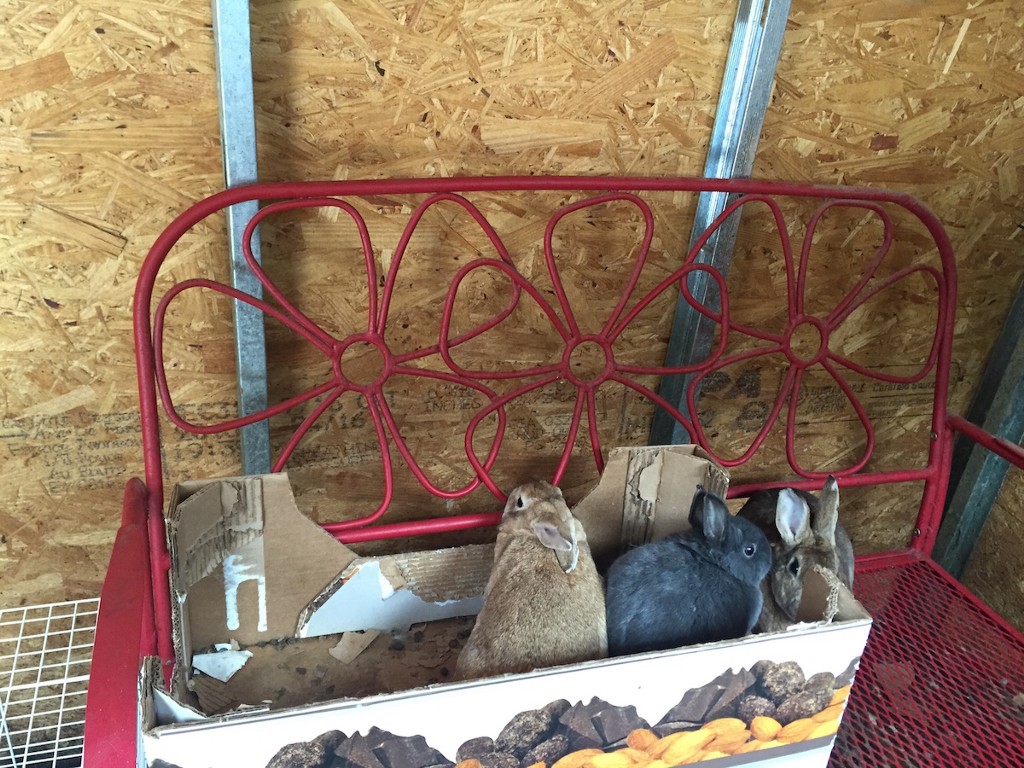The Rabbit Woman of Gowanus
by Rebecca McCarthy

Last Monday, during Winter Storm Juno, the NYPD seized seventy-four rabbits from a vacant lot behind a tire shop in Gowanus. On Thursday afternoon, the authorities returned. “When they went back I’m told that the basement of the entire shop was full of rabbits and they were in very, very, very bad condition,” Jeff1, who works for Rabbit Rescue and Rehab, told me. “Apparently, what this woman has been doing is culling the sick ones and segregating them from the ones that were hopping around the yard. The ones they got today, many of them had very serious injuries from fighting and many of them appear to have syphilis.”
Earlier that night, I was tending bar, and though I got to close early, it wasn’t early enough. The subways had shut down, all non-emergency vehicles had been ordered off the streets, and the four people I’d managed to get to come to the bar were stranded. Barricading the door and drinking all night was an option, but not a very appealing one, and we were a motley enough crew that we already sounded like a bad joke. An Irish guy, an Iranian, and two kids from Jersey get stuck in a bar… So, after closing the bar, we set out, through the two inches of snow that had brought the city to its knees, toward my friend Leila’s apartment. We made it to Ninth Street and Third Avenue when we saw the cops conducting a raid on what appeared to be a stash house. As we got closer, it became clear that it wasn’t drugs they were confiscating, it was rabbits. Not just a few rabbits, but a relentless stream of them, some in cages and some in cardboard carriers. The owner of the rabbits, Dorota Trec, and her landlord descended upon us almost immediately.
“They are taking my rabbits!” Trec said. She was a short woman, with a round face and a thick Polish accent. “They cut the lock on the gate!”
“I’m a journalist with the New York Times,” Fitz, my friend, said. “I’ll sort this out. Why are you wearing that mask?” The landlord was wearing a hospital mask.
“It’s cold,” the landlord said. We all nodded, as if that was a reasonable response.
“He’s not with the New York Times,” I said, pulling Fitz away as he started to walk into the lot.
“It doesn’t matter, just pretend,” Trec said. She grabbed Leila’s arm. “You pretend, say New York Times.”
“I clearly do not work for the New York Times,” Leila said. After some confusion we managed to make an escape, but when Leila and I walked by the tire shop the next morning, Trec and her landlord were sitting outside in a minivan. He’d ditched the hospital mask. Trec was wearing a lime-green peacoat and sweatpants with the words Trouble ❤’s Me printed down the left thigh. She rolled down the window when she saw us.
“Is that your real hair?” she asked Leila. Leila confirmed that it is her real hair. “You do not brush your hair.” Leila confirmed that she does not. With this out of the way, we were ushered into the yard where four rabbits that escaped the raid were still hopping around, doing bunny stuff.

“They are fine, you see? They are happy. Look at them, look how fat they are,” Trec said, pointing to a black rabbit. “Look at this bumblebee.” She was right on one count at least. The rabbits are fat and adorable, worthy of being called bumblebees, but a few of them had tufts of fur missing and I wouldn’t really say they looked happy. They looked like what they are — rabbits that live in a vacant lot behind a tire shop. That morning the yard was blanketed in snow and seemed almost quaint, but a day before the scene was much bleaker.
The rabbits had been there for a while. Trec told me that this is their third winter behind the tire shop, which is a point of pride for her. She believes she’s bred them to be tough.“The project is to have them outside to imitate wildlife,” she said. “Like they would live in nature.” There’s very little about 9th Street and 3rd Avenue that resembles nature though, and while rabbits do grow a second coat of fur in the winter, they are still mammals and therefore capable of freezing to death; they’re meant to live in burrows underground, not metal cages exposed to the elements.
Rabbit Rescue had dealt with Trec over the course of several months, and her complaints about them were not altogether coherent. “This woman,” she said, referring to someone who wants the rabbits spayed, “this ugly woman, she has no respect for their sexuality.” To put the sexuality of rabbits into perspective, they can be re-impregnated twenty-four hours after they give birth, they have between four to twelve babies in a litter, and the gestation period is about thirty days. It sounds pretty miserable. “One female and one male that have not been neutered can theoretically have seventy to a hundred rabbits in one year,” Jeff told me. “And you’re talking about a situation here where she had close to two hundred rabbits, she could’ve easily had a thousand in a very short period of time. This was a natural disaster waiting to happen.”

A friend of mine had a nervous breakdown a few years ago and in the months leading up to it he started hoarding things he found on the street. At first I thought it was a joke. Like, Haha, there’s a broken animatronic horse on the front stoop now. But he wasn’t laughing much those days, and the more he slipped away, the more useless shit he accumulated, as if he needed it for ballast. There was a piñata that became a particular point of contention. Every time someone went over to clean his room they would throw out the piñata and every time we went back it had reappeared, looking a little more battered. By the end of it my friend was sleeping in a tent on the roof. You could barely walk through his room, but the piñata was still sitting there atop the rubble, decapitated.
My friend has since made a full recovery, but at the time it was hard to broach the subject with him. There’s a profound loneliness to hoarding, especially animal hoarding. As a rule, hoarders are blind to the suffering of their animals, suffering that is blatantly obvious to anyone else. They don’t inflict pain intentionally. They often see themselves saviors, rescuing these animals from euthanasia or, in the case of the rabbits, someone’s dinner table. No single psychological disorder is to blame. There are elements of OCD, delusional disorder, and affective disorder, and the hoarders’ patterns of behavior bear distinct similarities to those of alcoholics. They deny the problem, they make the same elliptical excuses, and they seem oblivious to the damage they inflict upon those around them. But while men are over twice as likely to become alcoholics, a 1999 study showed that seventy-six percent of animal hoarders are women. Interviews conducted by The Hoarding of Animals Research Consortium suggests that “childhood experiences of abuse, neglect, or extreme instability in the family may play a role in the hoarding of animals” and “[the fact] that most people with this problem tend to be older and female suggests a developmental and gender-role link that may also have to do with feelings of vulnerability.” To some extent, animal hoarding seems like a misguided excess of love and it’s is often triggered by a traumatic event, like the death of a loved one. Desperately looking for something to care for, or something that will care for them, these people lose sight of reality and what began as good intentions often ends in tragedy.
Most people have a more tenuous grasp on reason than they’d like to believe. Anyone who’s lost someone has suffered at least a temporary break in sanity. “I should get a dog,” you think. “Dogs are loyal.” Suddenly, you’ve drunkenly agreed to adopt an English Mastiff. You stack books on one side of the bed so that it won’t feel so big, you tear up watching Drumline, and you find yourself unable to throw out anything that you associate with your ex-boyfriend. One day you’re cleaning out your dresser and you pull out his Speedo, think, “What the fuck is wrong with him, why did he have this?” And then suddenly you are holding a Speedo and sobbing.
Eventually, you get better. You put his old shit in a box, you move the books, you admit that you can’t take care of a dog at the moment, and you never watch Drumline again. But some people don’t get better. Some people drink themselves to death. Others sit in a vacant lot behind a tire shop, playing flute to almost two hundred rabbits.

I’m not trying to excuse Trec. I know very little about the woman or what kind of life she’s led. When I called her with follow-up questions about her background, she refused to comment. But it’s easy to demonize these kinds of people, and in a case like this, that’s not necessarily productive. She needs help, not just for her own sake but for the sake of any future pets. Without treatment, the recidivism rate among animal hoarders is somewhere between sixty to a hundred percent, so the rabbits might be rescued, but solving the actual problem is much more complicated and much messier. Bunnies pull at everyone’s heartstrings — people not so much. Bunnies will ever disappoint you like a human being.
All told, a hundred and seventy-nine rabbits were removed from the lot last week, although the woman who lives above the tire shop said she saw one straggler still hopping around Thursday night. Despite reports that they are tough, chicken wing-eating, scuzzbag rabbits, the ones I saw seemed pretty sweet, although it’s hard not to wonder what effect their proximity to the Gowanus Canal may have had on them. “I have one, he’s a big one,” Trec told me, somewhat ominously. “I have created a new breed I think. He’s a kangaroo, he is very strong. I do not think they got him, he’s hiding down in the tunnels.” She poked the rake under the hutch and I waited for some sort of colossal, mutant rabbit to materialize but the yard was quiet. “No,” she said, looking at the ground. “They could not get him.
1. Jeff requested that his real name not be printed, on account of possible litigation by Dorota Trec
